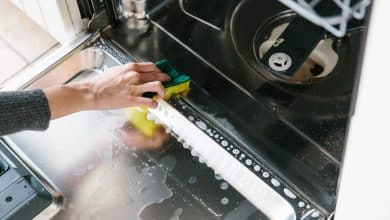It is ultimately up to you, as the homeowner, to keep your kitchen remodeling project expenses low. Contractors, subcontractors, architects, designers, and suppliers, among others, are all attempting to maximize their profits, just as you are attempting to optimize your savings. While it’s rare to work with someone who tries to deliberately blow holes in your budget by adding extra charges, you’ll almost certainly have to remind the secondary parties to stay on budget throughout the project. What’s easier to control are the remodeling choices you make to keep the costs manageable.
Here are four tips to lower your kitchen remodel budget.
Refresh Rather Than Replace the Cabinets

In general, all tear-out-and-replace projects are more expensive than projects that keep most of the materials. Kitchen cabinetry is a prime example of this. New kitchen cabinets can be very expensive, especially if you need custom-made pieces to fit your space. Fortunately, there are ways to refresh your existing cabinets that are both eco-friendly (because the old cabinets won’t end up in a dumpster) and cost-effective.
- Painting: Painting kitchen cabinets is a classic method of updating them. The process of sanding, priming, and painting can be time-consuming depending on how many cabinets you have. But it’s simple enough that beginners can achieve good results.
- Refacing: More expensive than painting, refacing adds a new veneer to the outside of the cabinet boxes and entirely replaces doors and drawer fronts. This is difficult to do yourself, as it requires tools and expertise that most DIYers don’t have. But it’s still cheaper than getting all new cabinets, and it will completely change your kitchen’s look.
- Hardware: In addition to the cabinet finish, consider updating the hardware. Sometimes modern knobs and handles are all it takes to make existing cabinets feel brand new.
- Shelving: Instead of purchasing new cabinets or refinishing your old ones, consider installing some open shelving. Shelves are inexpensive, and you can easily match them to your kitchen’s style, resulting in an airy feel almost like that of a commercial kitchen.
If you do need to replace cabinets, look for ready-to-assemble options. It’s typically not that difficult to assemble the pieces yourself, so you won’t have to pay for labor costs. But getting the right fit for your kitchen can be a challenge, especially if you have odd angles.
Refurbish the Appliances

In the past, many appliances were sent to the landfill during the course of a kitchen remodel. Thankfully, that antiquated thinking is on its way out, as municipalities have enacted restrictions against sending appliances directly to landfills.
Now, information about fixing kitchen appliances is readily available. And there’s a thriving online service parts marketplace. This makes it possible for many homeowners to refurbish their own appliances, rather than paying for a professional or spending money on something new.
Some appliances you can fix yourself include:
- Dishwasher
- Refrigerator
- Microwave
- Water heater
- Water softener
- Garbage disposal
Of course, the ability to repair an appliance depends on your skill level and whatever’s causing it not to function like new. But it’s often worth an attempt to DIY before you shell out more money.
Keep the Same Kitchen Layout

Dramatically changing the kitchen layout is one sure way to drive up the remodeling budget. For instance, moving plumbing for the sink, dishwasher, or refrigerator entails hiring plumbers. They’ll have to punch holes in your walls to run new pipes, which means an added cost of materials in addition to the labor.
On the other hand, keeping your kitchen layout essentially the same while updating the elements within that framework is incredibly cost-effective. You generally won’t have to add any new plumbing or electrical. You also can keep your existing flooring if you wish. (Flooring often doesn’t run under cabinets, so if you change the layout, you’ll have to deal with gaps in the flooring.) And you still can achieve a whole new look and feel in the space.
Furthermore, galley-style or corridor kitchens often have such limited space that footprint changes aren’t possible unless you want to spend a lot of money on major alterations to the home’s structure. One-wall kitchen layouts allow for a little more flexibility because they have an open side. In this case, adding a kitchen island is a great way to gain more prep space and storage without expensive layout changes.
Do Some Work Yourself

Do-it-yourself home remodeling projects allow you to pay for the materials while bringing labor costs down to zero. Some remodeling projects that require beginner to intermediate expertise from DIYers include:
- Interior painting
- Tiling
- Flooring installation
- Changing outlets and lights
- Hanging drywall
- Installing baseboards and other trim
Local hardware stores and community colleges often have how-to classes and demonstrations for common home projects. Plus, hardware store employees are usually available to offer advice on products and projects. Even better, these educational resources are often free of charge.
However, in addition to cost, an important factor to consider when deciding between DIY and hiring a professional is time. While a tight timetable typically means hiring a team of professionals, if you have the luxury of time to complete your kitchen remodel, you can do much of the work yourself.






